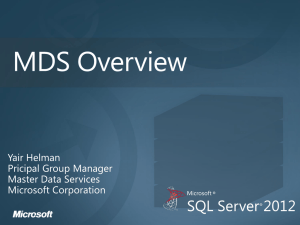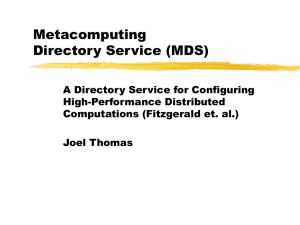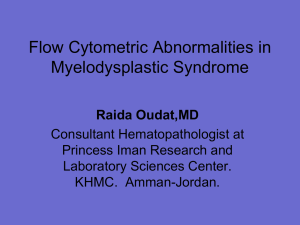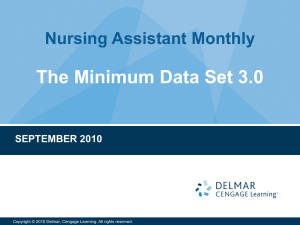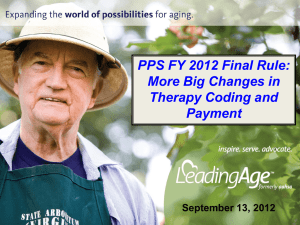RUG IV Overview
advertisement
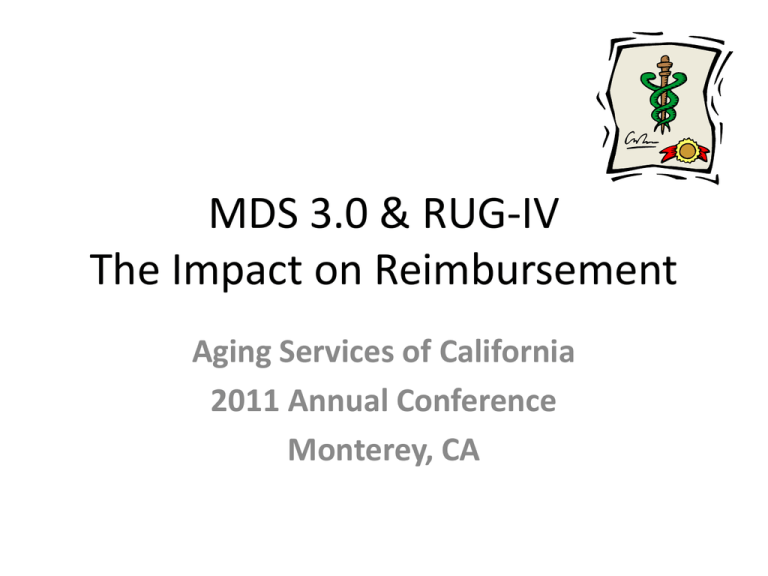
MDS 3.0 & RUG-IV The Impact on Reimbursement Aging Services of California 2011 Annual Conference Monterey, CA Presenter Michael Lesnick 714-323-5968 MikeL@axiomhc.com Jeannette Munkittrick 951-741-7195 Jeannettem@letrehab.com Axiom Healthcare Group RUG-IV Overview • What Are The Thirty (30) Most Critical Things To Know About RUG-IV? 3 RUG-IV Overview • What Are The Thirty (30) Most Critical Things To Know About RUG-IV? MDS 3.0, MDS 3.0, MDS 3.0, MDS 3.0. MDS 3.0, MDS 3.0, MDS 3.0, MDS 3.0, MDS 3.0. MDS 3.0, MDS 3.0, MDS 3.0, MDS 3.0, MDS 3.0. MDS 3.0, MDS 3.0, MDS 3.0, MDS 3.0, MDS 3.0. MDS 3.0, MDS 3.0, MDS 3.0, MDS 3.0, MDS 3.0. MDS 3.0, MDS 3.0, MDS 3.0, MDS 3.0, MDS 3.0, MDS 3.0 4 RUG-IV Overview Implementation Date • Originally 10-1-2011 • Now Payment Under RUG-IV Effective 10-1-2010 With A “Catch” • Starting 10-1-10 you will be paid under the 66 category RUG-IV classification system, BUT, you will be earning the 53 category “RUG-III HYBRID” rates • GREAT NEWS – RUG IV Delay Is Repealed! There will NOT be a RUG III Hybrid To Deal With 5 RUG-IV Adjustment to RUG-III HYBRID • • • Currently the only “Grouper Software” that will function under MDS 3.0 will only produce the RUG-IV grouping In other words CMS can NOT comply with the law that mandates a RUG-III payment under the MDS 3.0 Therefore, you get paid RUG-IV rates now and sometime in the coming months CMS will figure out how to take the difference between RUG-IV and RUG-III HYBRID rates back from you • GREAT NEWS – RUG IV Delay Is Repealed! There will NOT be a RUG III Hybrid To Deal With! • Happy Holidays! President Obama has delivered the LTC industry with a holiday gift by signing into law the Medicare and Medicaid Extenders Act of 2010. Section 202 of the MMEA repeals the delay of the Skilled Nursing Facility (SNF) PPS RUG-IV classification system. Therefore, RUG- IV will continue to remain in effect from October 1, 2010, as previously implemented by the final SNF payment regulation for FY 2011. All claims processing activities shall proceed in accordance with the existing instructions. (Big Sigh) And to All a Good Night! 6 NEW Rates Look GREAT!!!! Or Do They???????????????? • If you simply compare the “Old Rates” (FY 10 Rates) to the New Rates (the FY 11 Rates) It looks like you will have a very significant increase. • Please be aware that under MDS 3.0 and the new rules about Therapy Minutes and Look Back Periods, it will be much more difficult to achieve the higher RUG categories and to get Therapy minutes recorded. • Also, remember you are earning only the RUG-III Hybrid rates that are lower than the RUG-IV rates 7 New Conditions for Classification • Six new conditions added to the system to aid in the classification of resident care – Ventilator or Respirator Care – Tracheostomy Care – Isolation for Active Infectious Disease – Shortness of Breath when Lying Flat Combined with Emphysema or COPD – Parkinson’s Disease – Respiratory Failure with Oxygen Therapy Why Is It More Difficult To Get Into Various RUG Categories? • Extensive • Rehabilitation • ADL scale changes 9 More Difficult To Get Into Extensive Categories To date, the vast majority of the extensive qualifiers occurred in the acute care hospital before admission to the SNF • Look Back Periods will be modified to prohibit providers from taking credit for certain services (specifically the extensive qualifiers) that occur in the acute care hospital before admission to the SNF • For RUG-IV purposes, the look back period for section P1a items will NOT include any services rendered before the patient was admitted to the SNF • Services prior to admission (those provided in the hospital) are still recorded, but, only for Care Planning purposes, not for reimbursement purposes 10 More Difficult To Get Into Extensive Categories Qualifiers for Extensive Categories Have Changed • The Number of Extensive “qualifiers” is reduced • The Remaining Extensive qualifiers are: – Existing - Tracheotomy Care – IN THE NURSING HOME ONLY – Existing - Ventilator / Respirator Care – IN THE NURSING HOME ONLY – NEW – Isolation – “QUARANTINE” for an active infectious disease – IN THE NURSING HOME ONLY 11 What Is Isolation – QUARANTINE? • Examples Of Conditions That Do Qualify – – – – Active Cases of TB Neutropenic Precautions – Isolation (look it up) Active Shingles (Airborne) MSRA In The Respiratory Tract with Wet Productive Cough (Airborne) • Examples of Conditions That Do NOT Qualify – – – – “Normal” MDROs (Multi Drug Resistant Organisms) MSRA VRE Not What SNFs Typically Call Isolation 12 Criteria for QUARANTINE Must meet the following criteria: 1. Active contagious disease 2. Precautions over and above standard precautions 3. Alone in a room 4. Cannot come out of the room 13 Extensive Qualifiers That Have Been Eliminated • Some of the services that were formerly extensive “qualifiers” will be moved to other categories – Parenteral / IV Feeding moves to Special Care – High – IV Medications moves to Clinically Complex – Suctioning has been dropped completely as a qualifier 14 Why Is It More Difficult To Get Into REHAB Categories? • Section T Eliminated • Counting Minutes Modified – Concurrent Therapy – Aide Time 15 Counting Rehab Minutes RUG-IV Significant Changes • Revisions to calculation of Therapy minutes will be implemented. You will need to indicate on the MDS 3.0 what delivery “mode” is being used for rehab services: – Individual Therapy – Group Therapy – Concurrent Therapy 16 Counting Rehab Minutes • Aide Time – Is essentially limited to set up time • The old practice of counting all of the aides time (for a Part-A patient) under line of sight supervision by a licensed therapist is no longer acceptable, only the setup time is counted while in direct line-of -sight 17 Counting Rehab Minutes • The manner in which Therapy minutes are counted has been modified • Method Of Rehab Delivery – Individual Therapy – No Change – Group Therapy – No Change (Be Careful About Coverage Criteria) – Concurrent Therapy – Minutes Will be allocated / Limited to 2 patients (1/2 of time counted for reimbursement purposes) 18 Calculating Therapy Minutes • Residents can receive different modes of therapy on one day, or even in one treatment session – Each mode of therapy and the time spent on each must be recorded • Reportable treatment time begins when the patient starts the first task or activity, and ends when they finish with the last task, or piece of equipment – Count the total number of minutes spent on therapeutic activities, subtracting any time spent on breaks, or other activities that do not qualify as therapeutic Calculating Therapy Minutes • Only include minutes spent on skilled therapy • When Individual therapy occurs intermittently throughout the day, the total number of minutes from all sessions will be recorded as a daily count • When reporting therapy time, report the actual minutes of therapy – Do not round to the nearest 5th minute – The system will automatically do any necessary rounding, so report actual therapy minutes – The claim may not match the MDS exactly ADL Changes RUG-III • Maximum number of ADL points was 15 • Scale that ranged from 4 to 18 • Three areas scored from 1 to 5, with eating being given a score from 1 to 3 RUG-IV • Maximum number of ADL points is 16 • Scale ranges from 0 to 16 • Each of the four areas are given a score from 0 to 4 • New scores in the SelfPerformance Score for ADLs – Will produce an overall score of zero for that ADL ADL Changes ADL Category Self-Performance Score Support Score ADL Score Bed Mobility -,0,1,7, or 8 2 3 4 3 or 4 (any #) (any #) -, 0-2 -, 0-2 3 0 1 2 3 4 -,0,1,2,7, or 8 -,0,1,2,7, or 8 3 or 4 3 4 -,0,1 or 8 2 or 3 -,0,1 or 8 2 or 3 2 or 3 0 2 2 3 4 Transfer Toilet Use Eating New MDS 3.0 Item Sets • Medicare short stay • EOT OMRA • SOT OMRA 23 End of Therapy (EOT) OMRA • Patient was receiving rehabilitation services • Was classified to a rehabilitation RUG • Discontinues all rehabilitation services • Continues to have a skilled level of care requirement End of Therapy (EOT) OMRA • Assessment Reference Date (ARD) must be set on Day 1, 2 or 3 after the last day of any rehabilitation – Day 1 corresponds to the first day on which your facility would have normally provided therapy services – Whether the resident would have received therapy that day or not End of Therapy (EOT) OMRA • Payment rate changes beginning the day following the last day of therapy – Indicated in Item Z0150A of the MDS – Regardless of the ARD • No penalty for an early ARD if set on a day that therapy is not normally provided • May be combined with a scheduled assessment, but may not replace it Start of Therapy (SOT) OMRA • New assessment type • Optional assessment type • Can be done at any time during the resident’s stay to obtain a therapy RUG • ARD must be five to seven days after the start of the first therapy Start of Therapy (SOT) OMRA • Payment rate starts on the first day that therapy services were received • This assessment should not be combined with the 5-Day PPS assessment • Should only be completed if doing so will place the resident in a therapy RUG – Assessment will reject on the validation report Start of Therapy (SOT) OMRA • Pay close attention to your case mix indices – May not be in the facility’s best financial interest to place the resident in a therapy RUG – Optional assessment – Should only be completed if there is financial benefit Medicare Short Stay Assessment • Before the eighth day of the covered SNF stay – Resident dies – Resident is discharged from the SNF – Resident is discharged from a Medicare-Part A covered level of care Medicare Short Stay Assessment • Allows the resident to be classified to a Rehabilitation category when a resident was not able to have received five days of therapy • Eight conditions, and all must be met Medicare Short Stay Assessment • Must be a Start of Therapy OMRA (A0310C = 1 or 3) – May be completed alone or combined with any OBRA assessment – May be combined with a PPS 5-day or readmission/return assessment – May not be combined with a PPS 14-day, 30-day, 60-day, or 90-day assessment Medicare Short Stay Assessment • PPS 5-day (A0310B = 01) or readmission/ return assessment (A0310B = 06) has been completed – May be completed alone or combined with the Start of Therapy OMRA • ARD (A2300) of the Start of Therapy OMRA must be on or before the 8th day of the Part A Medicare stay Medicare Short Stay Assessment • ARD (A2300) of the Start of Therapy OMRA must be the last day of the Medicare Part A stay – Start of Therapy OMRA ARD must equal the end of Medicare stay date (A2400C) – End of the Medicare stay date is the date Part A ended Medicare Short Stay Assessment • ARD (A2300) of the Start of Therapy OMRA may not be more than 3 days after the start of therapy date – Item O0400A5, O0400B5 or O0400C5, whichever is earliest • Rehabilitation therapy (PT, OT, or SLP) started during the last 4 days of the Medicare Part A covered stay (including weekends) Medicare Short Stay Assessment • At least one therapy discipline continued through the last day of the Medicare Part A stay – Must have a dash-filled end of therapy date (O0400A6, O0400B6 or O0400C6), or – End of therapy date equal to the end of covered Medicare stay date (A2400C) Medicare Short Stay Assessment • RUG group assigned to the Start of Therapy OMRA must be Rehabilitation Plus Extensive Services or a Rehabilitation group (Z0100A) – If the RUG group assigned is not a Rehabilitation Plus Extensive Services or a Rehabilitation group, the assessment will be rejected Medicare Short Stay Assessment • If all eight of these conditions are met, then MDS Item Z0100C (Medicare Short Stay Assessment indicator) is coded 'Yes' • Assignment of the RUG-IV rehabilitation therapy classification is calculated based on average daily minutes actually provided Medicare Short Stay Assessment • Resulting RUG-IV group is recorded in MDS Item Z0100A (Medicare Part A HIPPS Code) – 15-29 average daily therapy minutes - Rehabilitation Low category (RLx) – 30-64 average daily therapy minutes - Rehabilitation Medium category (RMx) – 65-99 average daily therapy minutes - Rehabilitation High category (RHx) – 100-143 average daily therapy minutes - Rehabilitation Very High category (RVx) – 144 or greater average daily therapy minutes - Rehabilitation Ultra High category (RUx) Medicare Short Stay Assessment • If the earliest start of therapy date is the first day of the short stay, use the Medicare Short Stay assessment Medicare Part A RUG (Z0100) from the beginning of the short stay through the end of the stay – Dates in Items O0400A5, O0400B5 or O0400C5 – Medicare stay must be 4 days or less Medicare Short Stay Assessment • If the earliest start of therapy date is after the first day of the short stay – If a 5-day or readmission/return assessment was completed prior to Medicare Short Stay assessment, • Use the Medicare Part A RUG (Z0100A) from that assessment for the first day of the short stay through the day before therapy started; • Then use the Medicare Part A RUG (Z0100A) from the Medicare Short Stay assessment from the day therapy started through the end of the short stay Medicare Short Stay Assessment • If the earliest start of therapy date is after the first day of the short stay – If the Start of Therapy OMRA is combined with a 5-day or readmission/return assessment, • Use the Medicare Part A non-therapy RUG (Z0150A) for the first day of the short stay through the day before therapy started; • Use the Medicare Part A RUG (Z0100A) from the day therapy started through the end of the short stay Early Assessments • If an assessment is performed earlier than the schedule indicates, the provider will be paid at the default rate for the number of days the assessment was out of compliance • No penalty if an End of Therapy OMRA is performed early if the ARD is set on a day that therapy services are not normally available at your facility Late Assessment • If the ARD on the late assessment is set before the end of the payment period for that assessment – SNF will receive the default rate from the beginning of the payment period until the day before the ARD – From the ARD to the end of that payment period, it will receive the HIPPS rate identified by the assessment Late Assessment • PPS assessments must be timely, in order to bill the RUG generated by the assessment • If the assessment is missed and the resident is no longer on Part A when discovered, Medicare Part A cannot be billed at all! No one else can be billed for those days either. The facility is liable • A PPS assessment is timely if the ARD is set: – On the MDS – Within the prescribed ARD window – Before the end of the last day of the window RUG-IV Impact Impact On Rates / Payments • Overall Payments to SNFs Are expected to be “Budget Neutral”, BUT, there will be a SIGNIFICANT re-shuffling of the payments among categories 46 RUG-IV Impact Winners & Losers • In a very global sense, therapy services will be worth less and complex medical services (actually performed in the SNF) will be worth more 47 RUG-IV Impact Winners & Losers • SNF Most Likely to be negatively affected – SNFs with a high percentage, over 35% of “X”s and “L”s (Rehab PLUS Extensive category patients) that are based on “extensive” services provided in the acute care hospital – SNFs with a high percentage of Rehab Category Patients (over 75% to 80%) 48 RUG-IV Impact Winners & Losers • Payments for the Special Care (High & Low) and Clinically Complex categories will be worth more relative to the old RUG-III rates 49 RUG-IV Impact RUG-IV Categories • Total Number of Categories will change from 53 to 66 • There will be a variety of changes within the categories 50 RUG-IV Impact • RUG-IV Categories: – Extensive plus Rehab Services – Rehab Categories – Extensive Services – Special Care High – Special Care Low – Clinically Complex – Behavioral & Impaired Cognition – Reduced Physical Function 51 RUG-IV Impact RUG-IV Other Issues Level of Care / “Presumption of Coverage” • # of categories will change where there is at least an initial presumption of coverage. • 52 Upper • 14 Lower 52 RUG-IV Strategy RUG-IV Strategies • Work with your therapy vendors as soon as possible to adapt to RUG-IV. Focus on the following with them: • New Methods for counting minutes • Concurrent Therapy • Group Therapy – Does It Meet Coverage Criteria? • New Payment Levels for Rehab Categories • Use of Therapy Aides 53 Concurrent & Group Therapy • Concurrent & Group Therapy are GOOD if utilized PROPERLY • Concurrent and Group Therapy are still allowable and should be used in the appropriate situations • However, you need to understand the LIMITS that apply to each mode of delivery 54 RUG-IV Strategy RUG-IV Strategies • Work with your clinical staff to enhance your capacity to provide clinically complex services such as Ventilator/Respirator and quarantine, IN YOUR SNF 55 RUG-IV Strategy RUG-IV Strategies • Enhance Your capacity to complete complex services including, but not limited to: – IV Services – Complex Wound Care – Respiratory & Cardio Respiratory Programs 56 RUG-IV Strategy • Understand NEW assessment types. • Providers may opt NOT TO COMPLETE the SOT OMRA, if the non rehab RUG calculated by the most recent assessment has a HIGHER rate than a SOT OMRA would provide • Again test the “what if” scenarios with your RUGs rate sheet; just like you should do with your ARD! RUG-IV Strategy • DANGER – What Medicare Gives, the OIG and Take Away • Please Read the OIG Report “Questionable Billing Practices By Skilled Nursing Facilities” • After you have read this report, take the appropriate actions to protect yourself against and billing problems. 58 RUG-IV Overview • Q&A 59
